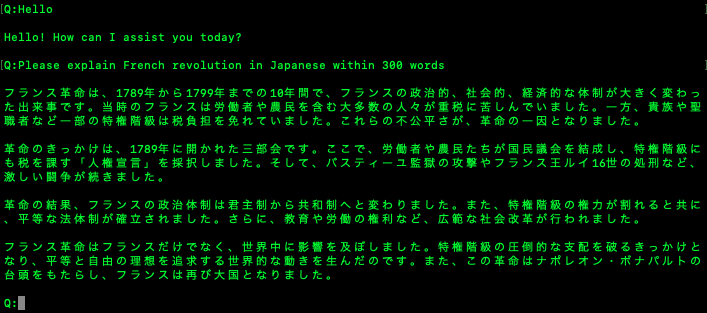1. インストール
Open AI Pythonライブラリーをインストール
pip install openai
2. デプロイ
Azure OpenAIのGPT4をデプロイ
export RES_GRP="MyResGrp"
export OPENAI_RES_NAME1="MyOpenAIResName"
export DEPLOY_NAME="MyModel"
export REGION="eastus"
export MODEL_NAME="gpt-4"
export MODEL_VERSION="0613"
##########################################
# Set subscription
az account set --subscription 'Your subscription'
#################################
# Create Resource Group
az group create --name $RES_GRP --location $REGION
#################################
# Create OpenAI Resource
az cognitiveservices account create --name $OPENAI_RES_NAME1 --resource-group $RES_GRP --location $REGION --kind OpenAI --sku s0
#################################
# Deploy model
az cognitiveservices account deployment create --name $OPENAI_RES_NAME1 --resource-group $RES_GRP --deployment-name $DEPLOY_NAME --model-name $MODEL_NAME --model-version $MODEL_VERSION --model-format OpenAI --sku-capacity "1" --sku-name "Standard"
3. アクセスキー・エンドポイントの設定
アプリケーションからAzure OpenAIにアクセスするためには、アクセスキーとエンドポイントが必要。
エンドポイント、および、アクセスキーを取得
# エンドポイントのURLを取得
az cognitiveservices account show --name $OPENAI_RES_NAME1 --resource-group $RES_GRP | jq -r .properties.endpoint
# アクセスキーを取得
az cognitiveservices account keys list --name $OPENAI_RES_NAME1 --resource-group $RES_GRP | jq -r .key1
取得したエンドポイント、および、アクセスキーを.profileに記載
export AZURE_OPENAI_API_KEY="0123456a3c6a401234567c41f3212345"
export AZURE_OPENAI_ENDPOINT="https://xxx.yyy.zzzzzz.microsoft.com/"
シェルを再起動
exec $SHELL -l
4. アプリケーションの実行
MSDNのチュートリアルのサンプルを実行
import os
from openai import AzureOpenAI
client = AzureOpenAI(
api_key = os.getenv("AZURE_OPENAI_API_KEY"),
api_version = "2024-02-01",
azure_endpoint = os.getenv("AZURE_OPENAI_ENDPOINT")
)
conversation=[{"role": "system", "content": "You are a helpful assistant."}]
while True:
user_input = input("Q:")
conversation.append({"role": "user", "content": user_input})
response = client.chat.completions.create(
model="MyModel",
messages=conversation
)
conversation.append({"role": "assistant", "content": response.choices[0].message.content})
print("\n" + response.choices[0].message.content + "\n")
5. アプリケーションの実行結果
アプリケーションの実行結果は、例えば以下のようになる
6. リソースの削除
課金されないように、アプリケーションのテストが済んだらリソースを削除する
az cognitiveservices account deployment delete --name $OPENAI_RES_NAME1 --resource-group $RES_GRP --deployment-name $DEPLOY_NAME
az group delete --name $RES_GRP
7. 他のモデルの使用
GPT3.5 Turboを使用する場合、モデル名・バージョンを変更する
export MODEL_NAME="gpt-35-turbo"
export MODEL_VERSION="0125"
